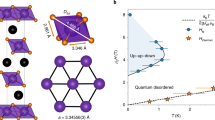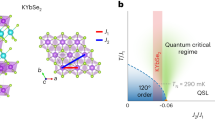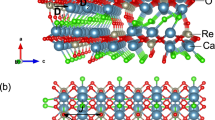Abstract
It has long been hoped that spin liquid states might be observed in materials that realize the triangular-lattice Hubbard model. However, weak spin–orbit coupling and other small perturbations often induce conventional spin freezing or magnetic ordering. Sufficiently strong spin–orbit coupling, however, can renormalize the electronic wavefunction and induce anisotropic exchange interactions that promote magnetic frustration. Here we show that the cooperative interplay of spin–orbit coupling and correlation effects in the triangular-lattice magnet NaRuO2 produces an inherently fluctuating magnetic ground state. Despite the presence of a charge gap, we find that low-temperature spin excitations generate a metal-like term in the specific heat and a continuum of excitations in neutron scattering, reminiscent of spin liquid states previously found in triangular-lattice organic magnets. Further cooling produces a crossover into a different, highly disordered spin state whose dynamic spin autocorrelation function reflects persistent fluctuations. These findings establish NaRuO2 as a cousin to organic, Heisenberg spin liquid compounds with a low-temperature crossover in quantum disorder.
This is a preview of subscription content, access via your institution
Access options
Access Nature and 54 other Nature Portfolio journals
Get Nature+, our best-value online-access subscription
$29.99 / 30 days
cancel any time
Subscribe to this journal
Receive 12 print issues and online access
$209.00 per year
only $17.42 per issue
Buy this article
- Purchase on Springer Link
- Instant access to full article PDF
Prices may be subject to local taxes which are calculated during checkout




Similar content being viewed by others
Data availability
The data that support the findings of this study are available at https://doi.org/10.25349/D9R626.
References
Morita, H., Watanabe, S. & Imada, M. Nonmagnetic insulating states near the Mott transitions on lattices with geometrical frustration and implications for κ-(ET)2Cu2(CN)3. J. Phys. Soc. Jpn 71, 2109–2112 (2002).
Sahebsara, P. & Senechal, D. Hubbard model on the triangular lattice: spiral order and spin liquid. Phys. Rev. Lett. 100, 136402 (2008).
Laubach, M., Thomale, R., Platt, C., Hanke, W. & Li, G. Phase diagram of the Hubbard model on the anisotropic triangular lattice. Phys. Rev. B 91, 245125 (2015).
Yamashita, S. et al. Thermodynamic properties of a spin-1/2 spin-liquid state in a κ-type organic salt. Nat. Phys. 4, 459–462 (2008).
Isono, T. et al. Gapless quantum spin liquid in an organic spin-1/2 triangular-lattice κ−H3(Cat-EDT-TTF)2. Phys. Rev. Lett. 112, 177201 (2014).
Itou, T., Oyamada, A., Maegawa, S., Tamura, M. & Kato, R. Quantum spin liquid in the spin-1/2 triangular antiferromagnet EtMe3Sb[Pd(dmit)2]2. Phys. Rev. B 77, 104413 (2008).
Shimizu, Y., Miyagawa, K., Kanoda, K., Maesato, M. & Saito, G. Spin liquid state in an organic Mott insulator with a triangular lattice. Phys. Rev. Lett. 91, 107001 (2003).
Bordelon, M. M. et al. Field-tunable quantum disordered ground state in the triangular-lattice antiferromagnet NaYbO2. Nat. Phys. 15, 1058–1064 (2019).
Mackenzie, A. P. The properties of ultrapure delafossite metals. Rep. Prog. Phys. 80, 032501 (2017).
Collins, M. F. & Petrenko, O. A. Review/Synthèse: triangular antiferromagnets. Can. J. Phys. 75, 605–655 (1997).
Kim, B. J. et al. Novel Jeff = 1/2 Mott state induced by relativistic spin-orbit coupling in Sr2IrO4. Phys. Rev. Lett. 101, 076402 (2008).
Moon, S. J. et al. Dimensionality-controlled insulator-metal transition and correlated metallic state in 5d transition metal oxides Srn+1IrnO3n+1 (n = 1, 2, and ∞). Phys. Rev. Lett. 101, 226402 (2008).
Plumb, K. W. et al. α-RuCl3: a spin-orbit assisted Mott insulator on a honeycomb lattice. Phys. Rev. B 90, 041112(R) (2014).
Yadav, R. et al. Kitaev exchange and field-induced quantum spin-liquid states in honeycomb α-RuCl3. Sci. Rep. 6, 37925 (2016).
Koitzsch, A. et al. Jeff description of the honeycomb Mott insulator α−RuCl3. Phys. Rev. Lett. 117, 126403 (2016).
Shikano, M., Delmas, C. & Darriet, J. NaRuO2 and NaxRuO2yH2O: new oxide and oxyhydrate with two dimensional RuO2 layers. Inorg. Chem. 43, 1214–1216 (2004).
Yang, H.-Y., Läuchli, A. M., Mila, F. & Schmidt, K. P. Effective spin model for the spin-liquid phase of the Hubbard model on the triangular lattice. Phys. Rev. Lett. 105, 267204 (2010).
Kos, P. & Punk, M. Quantum spin liquid ground states of the Heisenberg-Kitaev model on the triangular lattice. Phys. Rev. B 95, 024421 (2017).
Li, K., Yu, S.-L. & Li, J.-X. Global phase diagram, possible chiral spin liquid, and topological superconductivity in the triangular Kitaev–Heisenberg model. New J. Phys. 17, 043032 (2015).
Ortiz, B. R., Sarte, P. M., Avidor, A. H. & Wilson, S. D. Defect control in the Heisenberg-Kitaev candidate material NaRuO2. Phys. Rev. Mater. 6, 104413 (2022).
Sinn, S. et al. Electronic structure of the Kitaev material α-RuCl3 probed by photoemission and inverse photoemission spectroscopies. Sci. Rep. 6, 39544 (2016).
Jamieson, H. C. & Manchester, F. D. The magnetic susceptibility of Pd, PdH and PdD between 4 and 300 K. J. Phys. F: Met. Phys. 2, 323 (1972).
Smith, S. J. et al. Heat capacities and thermodynamic functions of TiO2 anatase and rutile: analysis of phase stability. Am. Mineral. 94, 236–243 (2009).
Schliesser, J. M. & Woodfield, B. F. Lattice vacancies responsible for the linear dependence of the low-temperature heat capacity of insulating materials. Phys. Rev. B 91, 024109 (2015).
Ni, J. M. et al. Absence of magnetic thermal conductivity in the quantum spin liquid candidate EtMe3Sb[Pd(dmit)2]2. Phys. Rev. Lett. 123, 247204 (2019).
Yamashita, S., Yamamoto, T., Nakazawa, Y., Tamura, M. & Kato, R. Gapless spin liquid of an organic triangular compound evidenced by thermodynamic measurements. Nat. Commun. 2, 275 (2011).
Schröder, A., Aeppli, G., Bucher, E., Ramazashvili, R. & Coleman, P. Scaling of magnetic fluctuations near a quantum phase transition. Phys. Rev. Lett. 80, 5623 (1998).
Sachdev, S. & Ye, J. Universal quantum-critical dynamics of two-dimensional antiferromagnets. Phys. Rev. Lett. 69, 2411 (1992).
Noakes, D. R. & Kalvius, G. M. Anomalous zero-field muon spin relaxation in highly disordered magnets. Phys. Rev. B 56, 2352 (1997).
Hodges, J. A. et al. First-order transition in the spin dynamics of geometrically frustrated Yb2Ti2O7. Phys. Rev. Lett. 88, 077204 (2002).
Uemura, Y. J. et al. Spin fluctuations in frustrated kagomé lattice system SrCr8Ga4O19 studied by muon spin relaxation. Phys. Rev. Lett. 73, 3306 (1994).
Dally, R. et al. Short-range correlations in the magnetic ground state of Na4Ir3O8. Phys. Rev. Lett. 113, 247601 (2014).
Shockley, A. C., Bert, F., Orain, J. C., Okamoto, Y. & Mendels, P. Frozen state and spin liquid physics in Na4Ir3O8: an NMR study. Phys. Rev. Lett. 115, 047201 (2015).
Keren, A. Muons as probes of dynamical spin fluctuations: some new aspects. J. Phys.: Condens. Matter 16, S4603 (2004).
Keren, A., Mendels, P., Campbell, I. A. & Lord, J. Probing the spin-spin dynamical autocorrelation function in a spin glass above Tg via muon spin relaxation. Phys. Rev. B 77, 1386 (1996).
Robinson, K., Gibbs, G. V. & Ribbe, P. H. Quadratic elongation: a quantitative measure of distortion in coordination polyhedra. Science 172, 567–570 (1971).
Ye, F. et al. Direct evidence of a zigzag spin-chain structure in the honeycomb lattice: a neutron and X-ray diffraction investigation of single-crystal Na2IrO3. Phys. Rev. B 85, 180403(R) (2012).
Chun, S. H. et al. Direct evidence for dominant bond-directional interactions in a honeycomb lattice iridate Na2IrO3. Nat. Phys. 11, 462–466 (2015).
Banerjee, A. et al. Neutron scattering in the proximate quantum spin liquid α-RuCl3. Science 356, 1055–1059 (2017).
Cao, H. B. et al. Low-temperature crystal and magnetic structure of α−RuCl3. Phys. Rev. B 93, 134423 (2016).
Ye, F. et al. Direct evidence of a zigzag spin-chain structure in the honeycomb lattice: a neutron and X-ray diffraction investigation of single-crystal Na2IrO3. Phys. Rev. B 85, 180403 (2012).
Lee, S.-S. & Lee, P. A. U(1) gauge theory of the Hubbard model: spin liquid states and possible application to κ−(BEDT−TTF)2Cu2(CN)3. Phys. Rev. Lett. 95, 036403 (2005).
Motrunich, O. I. Variational study of triangular lattice spin-1/2 model with ring exchanges and spin liquid state in κ−(ET)2Cu2(CN)3. Phys. Rev. B 72, 045105 (2005).
Verger, L., Guignard, M. & Delmas, C. Sodium electrochemical deintercalation and intercalation in O3-NaRhO2 and P2-NaxRhO2 layered oxides. Inorg. Chem. 58, 2543–2549 (2019).
Granroth, G. E. et al. SEQUOIA: a newly operating chopper spectrometer at the SNS. J. Phys.: Conf. Ser. 251, 012058 (2010).
Ehlers, G., Podlesnyak, A. A. & Kolesniko, A. I. The cold neutron chopper spectrometer at the Spallation Neutron Source—a review of the first 8 years of operation. Rev. Sci. Instrum. 87, 093902 (2016).
Bain, G. A. & Berry, J. F. Diamagnetic corrections and Pascal’s constants. J. Chem. Educ. 85, 532 (2008).
Suter, A. & Wojek, B. M. Musrfit: a free platform-independent framework for μSR data analysis. Phys. Procedia 30, 69–73 (2012).
Kresse, G. & Furthmüller, J. Efficient iterative schemes for ab initio total-energy calculations using a plane-wave basis set. Phys. Rev. B 54, 11169 (1996).
Kressea, G. & Furthmüller, J. Efficiency of ab-initio total energy calculations for metals and semiconductors using a plane-wave basis set. Comput. Mater. Sci. 6, 15–50 (1996).
Blöchl, P. E. Projector augmented-wave method. Phys. Rev. B 50, 17953 (1994).
Kresse, G. & Joubert, D. From ultrasoft pseudopotentials to the projector augmented-wave method. Phys. Rev. B 59, 1758 (1999).
Blöchl, P. E., Jepsen, O. & Andersen, O. K. Improved tetrahedron method for Brillouin-zone integrations. Phys. Rev. B 49, 16223 (1994).
Setyawan, W. & Curtarolo, S. High-throughput electronic band structure calculations: challenges and tools. Comput. Mater. Sci. 49, 299–312 (2010).
Acknowledgements
We thank R. Valentí and L. Hozoi for sharing preliminary ab initio calculations of the magnetic exchange interactions. This work was supported by the US Department of Energy (DOE), Office of Science, Basic Energy Sciences, under award no. DE-SC0017752 (S.D.W., B.R.O. and P.M.S.). Work by L.B. was supported by the DOE, Office of Science, Basic Energy Sciences, under award no. DE-FG02-08ER46524. Part of this work is based on experiments performed at the Swiss Muon Source SμS, Paul Scherrer Institute, Villigen, Switzerland. R.S. and A.H. acknowledge support from the National Science Foundation (NSF) through Enabling Quantum Leap: Convergent Accelerated Discovery Foundries for Quantum Materials Science, Engineering and Information (Q-AMASE-i), Quantum Foundry at the University of California, Santa Barbara (DMR-1906325). A portion of this research used the resources at the High Flux Isotope Reactor and Spallation Neutron Source, a DOE Office of Science User Facility operated by the Oak Ridge National Laboratory. Use of the Advanced Photon Source at Argonne National Laboratory was supported by the US DOE, Office of Science, Office of Basic Energy Sciences, under contract no. DE-AC02-06CH11357. We thank the National Institute of Standards and Technology for access to their neutron facilities. Certain commercial equipment, instruments or materials are identified in this document. Such identification does not imply recommendation or endorsement by the National Institute of Standards and Technology, nor does it imply that the products identified are necessarily the best available for the purpose.
Author information
Authors and Affiliations
Contributions
S.D.W. wrote the manuscript with input from all the co-authors. B.R.O., P.M.S. and A.H. synthesized the material and performed the resistivity, magnetization and neutron scattering measurements. A.H. and R.S. performed the ab initio density functional theory calculations. E.K., M.J.G. and C.W. performed the muon spin relaxation measurements. A.I.K., C.M.B., D.M.P., K.M.T. and A.H.A. performed the neutron scattering measurements. L.B. provided theoretical insights into modelling the material. All the authors participated in the planning and discussions of experiments.
Corresponding author
Ethics declarations
Competing interests
The authors declare no competing interests.
Peer review
Peer review information
Nature Physics thanks Jie Ma and the other, anonymous, reviewer(s) for their contribution to the peer review of this work.
Additional information
Publisher’s note Springer Nature remains neutral with regard to jurisdictional claims in published maps and institutional affiliations.
Supplementary information
Supplementary Information
Supplementary Figs. 1–8 and Table 1.
Rights and permissions
Springer Nature or its licensor (e.g. a society or other partner) holds exclusive rights to this article under a publishing agreement with the author(s) or other rightsholder(s); author self-archiving of the accepted manuscript version of this article is solely governed by the terms of such publishing agreement and applicable law.
About this article
Cite this article
Ortiz, B.R., Sarte, P.M., Avidor, A.H. et al. Quantum disordered ground state in the triangular-lattice magnet NaRuO2. Nat. Phys. 19, 943–949 (2023). https://doi.org/10.1038/s41567-023-02039-x
Received:
Accepted:
Published:
Issue Date:
DOI: https://doi.org/10.1038/s41567-023-02039-x
This article is cited by
-
Coulomb exchange as source of Kitaev and off-diagonal symmetric anisotropic couplings
Communications Physics (2024)
-
NaRuO2: Kitaev-Heisenberg exchange in triangular-lattice setting
npj Quantum Materials (2023)
-
Spins don’t align here
Nature Physics (2023)
-
A jeff = 1/2 Kitaev material on the triangular lattice: the case of NaRuO2
npj Quantum Materials (2023)



